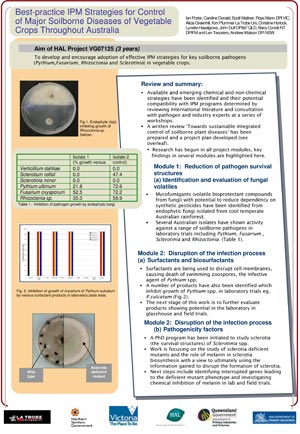|
Sclerotinia, one of the most significant vegetable diseases in Australia, causes between 15 and 25 million dollars in damage to crops each year.
This new project aims to solve Sclerotinia disease are being evaluated alone and integrated with conventional methods (e.g. fungicides).
The approach will identify the most effective and economical strategies to provide durable disease control and increased productivity and sustainability of vegetable production.
Authors
|
Oscar Villalta
|
Ian Porter
|
Caroline Donald
|
Denise Wite
|
Ross Mann
|
Scott Matter
|
Frank Hay
|
Sarah Pethybridge
|
Suzie Jones
|
Hoong Pung
|
| Sue Cross |
John Duff
|


New Approaches:
-
Reduction of inoculum carry-over using pre-plant soil treatments that reduce number of sclerotia survival in soil
-
Protect against below (S. minor, S. sclerotiorum) and above-ground (S. sclerotiorum) infection
-
Strengthen host crop resistance against infection
-
Disrupt the infection process
-
Better understand white mould epidemiology to develop methods to forecast infection risk and improve disease management
-
Better understand lettuce drop epidemiology to improve disease management
-
Economic analysis and extension activities
|

